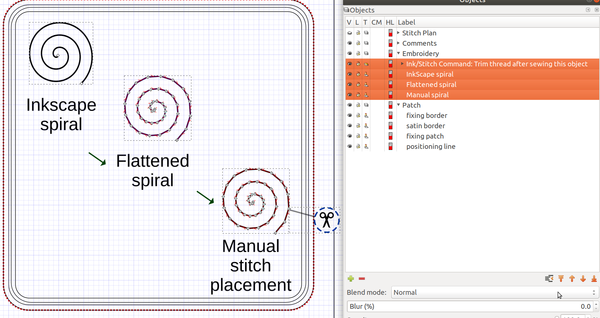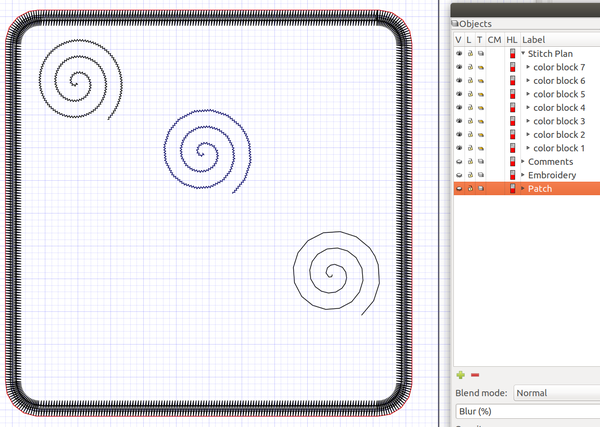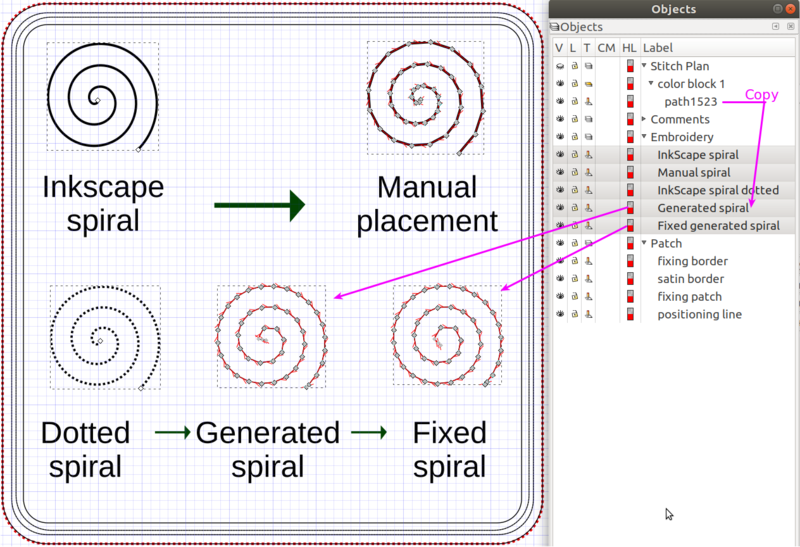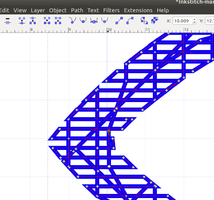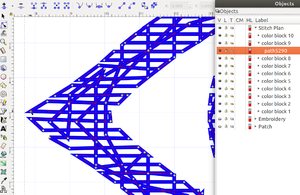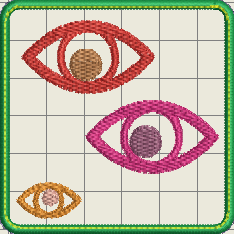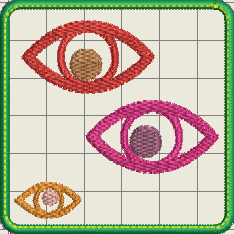InkStitch - manual stitches
Introduction
Most professional embroidery does at some point require some manual stitches, i.e. either embroidery objects ("stitch packs") that are not generated from parametrized design objects, or manual changes to generated "stitch packs".
You should understand that all generated stitches are like "manual stitches". The difference is that the generated ones do include locks stitches. In the explanations below we will firstly show how to create manual stitches directly, then show how to reuse and how to change generated stitches in the stitch plan layer. These techniques have in common the idea that Ink/Stitch will create stitch files from the layers that are visible:
- Objects that are not parametrized will not be stitched
- Visible layers, i.e. its parameterized objects will be translated to stitchable objects in a stitch plan layer and from these it will then create the machine code for for the propriatory stitch files.
- The objects in the stitch plan are just like the manual stitch objects. This means that they can be edited and also be copied to another layer. Make sure to never unhide both stitch layer and another layer. It is either one.
The example used also includes code for a border that you can ignore. Some of the SVG files are attached at the end.
Creating manual stitches
Creating manual stitches is easy, but requires adding lock stitches.
As explained in the official Manual Stitch page, the initial procedure is simple:
- Create a path. Line style or width are irrelevant.
- Open Extensions > Ink/Stitch > Params.
- Enable Manual stitch placement. The other settings will not have any effect in manual stitch mode.
Stitches are defined by the nodes that define a line. If your drawing has curve controls, these will not have any effect.
If your nodes are too far or too close, you will get stitches that are either too far or too close. A good way to visualize distances is to use the Grid
Edit -> Preferences -> Grids. Grid units = mm, set distances to 1 x 1 mm for example- turn the grid on with (Menu
View-> Page Grid
Tip: To transform a smooth form, e.g. the spiral in Inkscape into a series of small connected lines, do the following
- convert the shape to a path if necessary (Path -> Object to Path)
Extensions -> Modify Path -> Flatten Beziers. E.g. select a distance of 2. We used that setting to convert the spiral in the figure below.
You may have to remove, add or move some points using the node editor (F2)
Important tip: The example shown here does not have any lock stitches. You will have to add them if you don't want your embroidery to fall apart quickly. Attaching a command to the selected object does not seem to work (except for the Trim) at the time of writing. Therefore, create manual locks simply by moving back and forth 2-3 times in the beginning and the end.
Below we will show both a design view and resulting stitchable objects in the stitch plan. On top left, the original inkscape spiral which will be rendered in an ugly zig-zag. In the middle the flattened spiral, also by default rendered as zig-zag. At bottom right, the flattened object parametrized as <code>manual stitch placement</code> (as explained above)
Using generated stitches as design element
A more often used strategy is to generate a stitch plan defining all the stitches of your embroidery. In principle, InkStitch will create one stitchable object for design objects grouped together by color blocks. Let us call these objects stitchable objects. These objects can be edited since they are just composed of a long line defined by nodes. So far, we think that the best method of doing this is the following:
Step 1: Generate a stitchable object
- Create a design in InkScape
- e.g. create an InkScape Spiral, make it dotted ("Dotted spiral" in the figure below)
- Parametrize in Ink/Stitch
- e.g. in this example, we parametrize the spiral as a simple line (not that we have choice ...)
- Select just this object, then generate the Stitch Plan using
Extensions -> Ink/Stitch -> Embroider....
The result, a single path, will be placed in the Stitch Plan Layer, inside a color block group.
Step 2: Copy and edit the stitchable object
- The generated object in the Stitch plan layer, e.g. path1523 is a defined as manual path (like above), except that it also contains lock stitches in the beginning and at the end.
- Move this object into your embroidery layer ("Generated spiral" in the fig. below).
- Now edit the object, i.e. hit F2 and move, delete, add nodes. In the case shown in the figure below, we just moved nodes at the end and in the beginning. Make sure that when you move lock stitches (several stitches that go back and forth) together, this is a little bit tricky ....
Fixing generated stitches
The principle is the same as above, except that we do not copy stitch packs. Let us assume that you are perfectly happy with your design objects, but not with the generated stitches. In that case, we suggest generating the whole stitch packs and edit these in place, i.e. in the Stitch Plan directory.
The following example shows a modified small eye in the lower left. We displaced a underlay stitch and also elongated the eye a bit.
Important: In order to generate the modified embroidery file, keep the Stitch Plan unhidden and keep hidden all the other layers (do not regenerate) ! You can produce a stitch file either by clicking again on embroidery... again, or through "Save as".
Below is a simulation as seen in Wilcom Truesizer (since we use the DST format, colors are randomly chosen). The little eyes at the bottom of each look a bit different. The one to the right has a more pronounced left corner

